Recycling Plastic
3D printing doesn't have to be wasteful! Learn about PLA recycling, composting, and how to reduce waste with other materials like PETG.
When plastic is sent to a recycling center, it gets washed, sorted, shredded, then melted into small pellets, which are then used as raw material for manufacturing new products. Each of these steps can be done at a single facility or split across multiple sites.
Whether it’s done at one or many locations, the sorting stage is extremely important to the recycling process. Contaminating one type of recycled plastic with another can seriously reduce the strength and longevity of the final material. As a result, plastic sorting plants use a variety of methods to separate the types of plastic from one another, all the way from simple hand sorting to high-tech IR detectors!
What role do PLA and PETG play in this matter? In this article, we’ll go over how recyclable 3D printing filaments are, the possibility of composting, tips for reducing plastic waste, and more!
PETG / PLA RECYCLING: HOW TO RECYCLE 3D PRINTER WASTE
What Types of Plastic Are Recyclable?
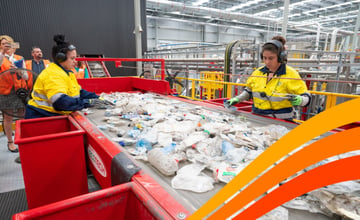
Plastic can be classified into two types: thermosets and thermoplastics.
Thermosets are materials that are molded, then cured into their final forms, They include materials such as polyurethane or silicone. In 3D printing, thermosets are typically the resins used in vat polymerization 3D printing. Typically, these are difficult to recycle (3D printed or not), so this article will focus on the other type of plastic.
Thermoplastics don’t have a curing step and can become pliable or workable after being heated above their melting temperatures. As a result, all FDM 3D printers use thermoplastic filament materials.
In theory, most types of thermoplastic can be melted down and recycled, with differing amounts of efficiency and material loss for each type. However, the types of plastics that are processed by recycling plants can vary significantly around the world, or even between different neighborhoods within the same city!
For example, almost every recycling center processes PET and HDPE, which are the materials that plastic bottles and food containers are usually made of. On the other hand, even though PVC is recycled extensively in Europe, it’s much less common in North America.
PETG / PLA RECYCLING: HOW TO RECYCLE 3D PRINTER WASTE
Is 3D Printer Filament Recyclable?
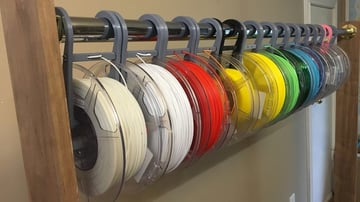
The two classic types of 3D printer filament, ABS and PLA, aren’t recycled by most curbside municipal recycling programs. Under the ASTM International Resin Identifier Codes, both are classified as Type 7, or “Other”, which is not typically processed by municipal programs. So, unfortunately, you can’t just throw your failed prints into the recycling bin.
Even though PETG and PET are chemically very similar, PETG is also excluded from being recycled by most programs. In fact, PETG is a pesky contaminant during the recycling of PET because their chemical similarity makes them difficult to distinguish and separate. Combining PETG into the normal PET recycling stream will give the mixed material a lower melting point and out-of-spec thermal stability, which ultimately means the mixture will get tossed in the incineration pile.
Polypropylene (PP) filament isn’t commonly used for 3D printing, as its semi-crystalline nature causes it to warp significantly while cooling. For the brave few that do print with PP, it’s recycled in some municipalities. Contact your local recycling center to find out whether they accept it or not.
Almost every other type of printer filament (including nylon and polycarbonate) are also classified as Type 7, so they aren’t usually processed by normal plastic recycling plants either.
PETG / PLA RECYCLING: HOW TO RECYCLE 3D PRINTER WASTE
Non-Municipal Recycling Centers
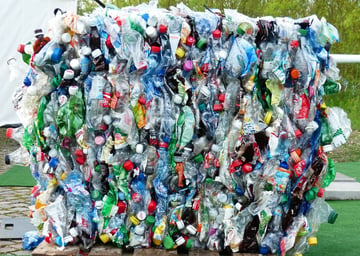
Even though most local recycling programs won’t turn your failed 3D prints into recycled plastic, there are many independent plastic recycling and processing companies that recycle the materials that aren’t processed by the local pickup service.
Try calling local recycling companies and asking whether they process your plastic of choice. You might need to try multiple places because even if a company processes a plastic type used in 3D printing, many companies might hesitate on accepting plastic waste from a non-verified source.
If, however, they’re willing to accept your waste materials, try accumulating big batches of waste plastic that you can periodically drop off. If you’re part of a Makerspace or FabLab, you can also make a big communal waste box for failed prints and take it over when it’s full. Just make sure to keep the different types of plastic separated, with the plastic types clearly marked!
PETG / PLA RECYCLING: HOW TO RECYCLE 3D PRINTER WASTE
PLA Composting
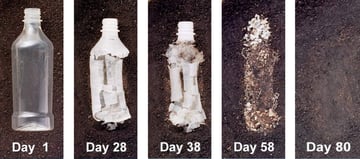
One of the unique features of PLA is that it’s a biodegradable plastic, which means it can be broken down over time by microorganisms like those found in industrial composting. This organic process could be a great way for us to deal with plastic waste without sending it to a landfill.
Composting PLA breaks down the plastic into smaller, harmless molecules such as carbon dioxide and water. The time frame in which this process takes place is heavily dependent on both environmental conditions and the material itself.
Industrial composting facilities can effectively break down PLA because they provide ideal conditions to keep those munching microorganisms thriving. This includes high temperatures, high humidity, and lots of food. These conditions are difficult to achieve in home composting setups, so it’s generally not practicable to compost PLA in your backyard.
Composting 3D printed parts can be a special challenge due to their geometry. Particularly important is the amount of exposed surface area the item has with the surrounding compost. Biodegradation testing is typically performed using thin films or sheets (like the water bottle pictured above). Printed PLA parts will be much thicker than this, making their degradation very slow, even under ideal conditions.
It’s important to note that while PLA is compostable under the right conditions and amount of time, most industrial composting facilities don’t yet have sufficient methods in place to handle this slowly degrading material and the potential contamination that it may bring. If you mix PLA into your food waste, it’ll probably end up getting removed from the compost and sent to a landfill anyway. For now, it’s best to keep this plastic out of the compost stream.
PETG / PLA RECYCLING: HOW TO RECYCLE 3D PRINTER WASTE
Tips for Reducing Plastic Waste
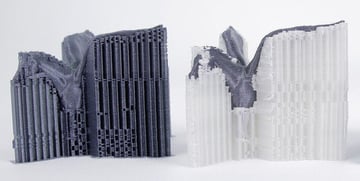
Even though the suggestions above can help you cut down on waste plastic buildup, the easiest way to reduce your waste is to prevent it from happening in the first place! Failed prints and prototypes are an inevitable source of waste for any 3D printing hobbyist, but here are some quick tips for preventing waste buildup:
- Eliminate supports as much as possible. Printing with supports results in a lot of wasted plastic and a lot of time removing it from the part. Whenever possible, try to print your models without supports, or design minimalistic supports into the part itself. (If you use slicing software like Simplify3D, you can also trim the number of supports manually.)
- Print with a brim instead of a raft. Rafts are a good way to ensure that the part will stick to the build surface of your printer. However, like supports, they use a lot of material and require extra steps to be removed from the part. If you’re having bed adhesion problems, try adjusting your first layer height, or print with a brim instead of a raft. Brims also help parts adhere to the bed but use significantly less plastic than a raft.
- Don’t print too many parts at once. The chance of a print failing tends to increase when too many parts are being printed at once. If the printing of one component fails, its aftermath will probably carry over to the other components on the bed, possibly ruining them as well. Try to separate multi-component projects into multiple prints rather than a single large one. It will take more time, but it might be worth it in the end!
- Keep up with printer maintenance. We all know how many things can go wrong during a print. While it’s difficult to prevent all possible mishaps, keeping a regular schedule of maintenance checks and calibrations can help prevent issues from arising. Fewer printing issues mean fewer prints ending up in the trash!
- Consider a print monitoring system. Catching print failures as soon as they begin can mean fewer platters of unusable filament spaghetti. Thankfully, this doesn’t mean standing next to your printer during the entire 8-hour print. There are many tools out there you can use to keep an eye on how your print is going. If you have OctoPrint set up, consider adding a webcam for remote monitoring or the Obico plug-in that can automatically detect print failures.
- Opt for recycled filaments. While making your own recycled filament is quite the task, there are lots of companies out there that take care of the process for you! Professionally recycled plastic can give you similar results to that of brand-new plastic, all while reducing your consumption of raw materials! There’s a range of options out there from ReFuel, which sells a filament made from the combination of all their manufacturing scraps, to Reflow, which sources high-quality plastics to make PLA and PETG filaments that are practically new. Many 3D printing services, like Craftcloud by All3DP, offer recycled filament as a material option for making your parts!

